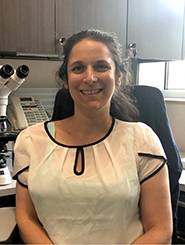NVDC News
An electronic newsletter for clients and stakeholders

November 2021
In this issue:
Notes from the director
Update on “Trich Direct Realtime PCR” Test: specimen stable for five days
Dr. Drozd now American College of Veterinary Pathologists Diplomate
One dose rabies-vaccinated canine dead from rabies
Dr. Dustin Loy awarded prestigious ISU Alumni Award
Emerging diseases
Mailing formalin-fixed tissues in the winter
Notes from the director
By Bruce Brodersen

This is sounding like a broken record, but SARS-CoV-2 testing for the campus community continues in the Nebraska Veterinary Diagnostic Center. However, the rate of testing has slowed considerably compared to the beginning of the fall semester.
As we move into colder weather, we recommend that preparations for BRD investigations be made. This includes having a supply of deep nasal swabs and appropriate transport media on hand. These supplies can be ordered from us through our website. The link to order supplies is located in a box halfway down the right side of the NVDC homepage or you can go to the Follow-up Testing and Supplies Order Form. If follow-up testing is to be requested on specific cases, those requests can be made on that same page.
Thank you for your support, best wishes and Happy Holidays.
Update on “Trich Direct Realtime PCR” Test: specimen stable for five days
Laura Leger, Dr. Duan Loy and Dr. Dustin Loy
Last year we introduced this test with the stipulation that the laboratory must receive the specimens within 72 hours. We listened to your comments and have done additional validation studies. The stability of refrigerated specimens in PBS when tested at five days is comparable to samples tested after three days. During stability and limit of detection studies, when diluted out, the equivalent of a single organism per microliter (1/1000 milliliter) was detectable after five days. Additionally, we tested freezing PBS samples in a frost-free freezer for seven days. At the equivalent of one organism per microliter dilution, Trichomonas RNA remained detectable. However, freezing for 14 days rendered the specimens unsuitable. We chose a frost-free freezer as it resembles what is common in most veterinary clinics. Frost-free freezers undergo cycles of heating and cooling in order to eliminate frost development. These changes in temperature result in degradation of specimens. If samples are frozen, they must be kept frozen during shipment to the laboratory.
If you have questions regarding T. foetus collection, storage, or shipment requirements please contact the NVDC at 402-472-8470. We continue to provide PBS transport media for collection for the cost of shipping.
Samples can be shipped to the Nebraska Veterinary Diagnostic Center using the UPS EZ-Ship option. Please visit the Shipping page of our website for more information and for the benefits of using the UPS EZ-Ship option.
Dr. Drozd now American College of Veterinary Pathologists Diplomate

We are proud to announce that Dr. Mary Drozd has passed her anatomic pathology board examinations to become a Diplomate in the American College of Veterinary Pathologists (ACVP). The ACVP certifying examination is a two-phase process that candidates must pass to be certified as a Diplomate in either veterinary anatomic or clinical pathology.
The Phase I examination tests knowledge of mechanisms fundamental to disease in animals such as principles of cellular injury, inflammation and repair, hemodynamic disorders, physical and chemical injury, neoplasia, congenital and genetic diseases, molecular pathology and infections. Phase I is taken after at least one year of training. The Phase II examination requires a minimum of 36 continuous months of training. This training involves performance and interpretation of gross, histologic, histochemical, immunohistochemical, molecular biological and ultrastructural examinations, and correlating results with clinical findings and clinical laboratory data. In addition to a list of recommended textbooks, the previous five years’ worth of literature in several refereed journals is representative of the current veterinary pathology knowledge required for the arduous eight-hour examination.
One dose rabies-vaccinated canine dead from rabies
Liping Xie and Dr. Korakrit Poonsuk
The Nebraska Veterinary Diagnostic Center received a specimen from a three-year-old German shepherd dog in October 2021 for rabies testing. According to the submitter from the veterinary clinic, this dog presented to clinic with a high fever. The dog was treated and released with antibiotics. Two days later the dog was recumbent at home and unable to stand. It was aggressive and had difficulty swallowing, which progressed to paralysis.
This dog received its first rabies vaccine at eight months of age in July 2019. This was the only dose ever given.
The brain was tested for rabies in the virology section of the Veterinary Diagnostic Center by means of Direct Fluorescent Antibody (DFA) testing. As for all rabies tests, slides are read independently by two technicians. Both technicians confirmed the sample was positive in all areas of brain that were examined (see figure below).
The dog brain tissue was forwarded to the CDC for Rabies Virus variant testing. The CDC gene sequencing results showed the virus variant was a 99.75% match with host Lasiurus cinereus (Hoary bat).
This case highlights the importance of a complete rabies vaccination sequence in young dogs, starting at three months of age. Nebraska statutes follow the vaccination recommendations from the Compendium of Animal Rabies Prevention and Control which is published in the Journal of the American Veterinary Medical Association.
To date, there have been 28 positive tests in Nebraska, compared to 25 in 2020 and 21 in 2019. Most of them have been bat origin. Additional rabies information for Nebraska can be found at the Nebraska Department of Health and Human Services website.

Dr. Dustin Loy awarded prestigious ISU Alumni Award

Dr. Dustin Loy has been awarded the Iowa State University Alumni Association Outstanding Young Alumni Award. In the photo, Dr. Jeff Johnson (left), ISU Alumni Association President, presents the ISU Outstanding Young Alumni Award to Dr. Loy
The award was established by the Iowa State University Alumni Association in 1968 to recognize ISU alumni, age 40 and under, who have excelled in their professions and provided service to their communities. Dr. Loy is one of two individuals presented with the 2021 award.
Dr. Loy, an associate professor at UNL, heads both the bacteriology and molecular diagnostics sections in the NVDC where, besides supervising testing and finalizing test results, he’s heavily involved with test development. He has a healthy research program focusing primarily on bacterial diseases of cattle and more specifically, bovine respiratory disease and keratoconjunctivitis (Pinkeye) of cattle. Dr. Loy heads the Public Health course for the Professional Program in Veterinary Medicine and a co-instructs the undergraduate Pathogenic Microbiology course at UNL. He also serves on the Lincoln-Lancaster County Board of Health and chairs committees for the American College of Veterinary Microbiologists and the American Association of Veterinary Laboratory Diagnosticians.
Emerging diseases
Dr. David Steffen
Dr. David Steffen is completing a research project regarding adult-onset blindness in beef cattle. Complete blindness is likely at 12-18 months. Onset is hard to establish, as it can be hard to detect early vision loss in many management systems. Cattle are very good at adapting in herd situations. Loss of the outer retinal layers is common to the animals examined. The anterior globe and cornea are normal. If you are aware of beef cows with adult-onset blindness and normal cornea, please contact Dr. Steffen at the laboratory for more information and diagnostic support.
Dr. Steffen is also investigating a myopathy in cattle. Problems in metabolism cause calves to dramatically slow or lie down when vigorously exercised. Occasionally, we see muscle fasciculation. Once the calves rest, they will again rise and behave normally. If not pushed hard the calves seem to perform reasonably well. If you have any calves behaving this way, please contact Dr. Steffen at the laboratory.
Mailing formalin-fixed tissues in the winter
As a reminder, shipping tissues in the winter poses the risk of freezing the specimen. Freezing creates significant artifacts in the tissues. These artifacts are almost always so severe that it prevents us from making a diagnosis. In order to prevent your biopsies from freezing, we recommend that you make a 9:1 mixture of your usual neutral buffered formalin with 95% ethanol (100% ethanol is expensive and not readily available because it is drinkable and thus subject to different taxation). The most accessible source of ethanol is denatured alcohol from the local paint store.